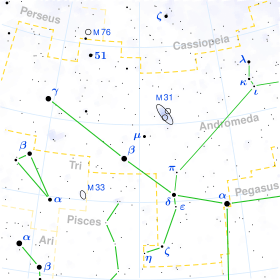Lambda Andromedae
 | |
| Observation data Epoch J2000 Equinox J2000 | |
|---|---|
| Constellation | Andromeda |
| Right ascension | 23h 37m 33.84261s[1] |
| Declination | +46° 27′ 29.3380″[1] |
| Apparent magnitude (V) | 3.65 - 4.05[2] |
| Characteristics | |
| Spectral type | G8 III-IV[3] |
| U−B color index | +0.688[4] |
| B−V color index | +0.996[4] |
| Variable type | RS CVn[2] |
| Astrometry | |
| Radial velocity (Rv) | +6.8[5] km/s |
| Proper motion (μ) | RA: +159.31[1] mas/yr Dec.: -422.38[1] mas/yr |
| Parallax (π) | 37.87 ± 0.21[1] mas |
| Distance | 86.1 ± 0.5 ly (26.4 ± 0.1 pc) |
| Absolute magnitude (MV) | 1.91[6] |
| Details | |
| Mass | 1.0 ± 0.2[3] M☉ |
| Radius | 7.0 ± 0.7[3] R☉ |
| Luminosity | 23.4[3] L☉ |
| Surface gravity (log g) | 2.75 ± 0.25[3] cgs |
| Temperature | 4,800 ± 100[3] K |
| Metallicity [Fe/H] | –0.56[7] dex |
| Rotation | 54 d[3] |
| Rotational velocity (v sin i) | 7.3[8] km/s |
| Other designations | |
| Database references | |
| SIMBAD | data |

Lambda Andromedae (λ And, λ Andromedae) is the Bayer designation for a binary star in the northern constellation of Andromeda. At an estimated distance of approximately 86.1 light-years (26.4 parsecs) from Earth,[1] it has an apparent visual magnitude of +3.8.[4] This is bright enough to be seen with the naked eye.
Lambda Andromedae is a single-lined spectroscopic binary with an orbital period of 20.5212 days.[10] The spectrum of the primary matches a stellar classification of G8 III-IV, suggesting that it is an evolved star that lies part way between the subgiant and giant stages. The mass of this star is similar to the Sun, but it has expanded to around seven times the Sun's radius. It is radiating over 23[3] times the luminosity of the Sun from its outer envelope at an effective temperature of 4,800 K,[3] giving it the characteristic yellow hue of a G-type star.
This is an RS Canum Venaticorum variable and its brightness varies by 0.225 magnitudes, reaching a maximum of 3.70, with a period of 54.2 days.[10] Such variability is theorized to occur because of tidal friction, which results in chromospheric activity. However, the orbit of this system is nearly circular, so the cause of this system's variability remains uncertain.[10] The X-ray luminosity of this star, as measured by the ROSAT satellite, is 2.95 × 1030 erg s−1.[3]
Naming
In Chinese, 螣蛇 (Téng Shé), meaning Flying Serpent, refers to an asterism consisting of λ Andromedae, α Lacertae, 4 Lacertae, π2 Cygni, π1 Cygni, HD 206267, ε Cephei, β Lacertae, σ Cassiopeiae, ρ Cassiopeiae, τ Cassiopeiae, AR Cassiopeiae, 9 Lacertae, 3 Andromedae, 7 Andromedae, 8 Andromedae, κ Andromedae, ι Andromedae, and ψ Andromedae. Consequently, λ Andromedae itself is known as 螣蛇十九 (Téng Shé shíjiǔ, English: the Nineteenth Star of Flying Serpent).[11]
References
- 1 2 3 4 5 6 van Leeuwen, F. (November 2007), "Validation of the new Hipparcos reduction", Astronomy and Astrophysics, 474 (2): 653–664, arXiv:0708.1752, Bibcode:2007A&A...474..653V, doi:10.1051/0004-6361:20078357.
- 1 2 Samus, N. N.; Durlevich, O. V.; et al. (2009). "VizieR Online Data Catalog: General Catalogue of Variable Stars (Samus+ 2007-2013)". VizieR On-line Data Catalog: B/gcvs. Originally published in: 2009yCat....102025S. 1. Bibcode:2009yCat....102025S.
- 1 2 3 4 5 6 7 8 9 10 Drake, Jeremy J.; et al. (November 2011), "Close to the dredge: precise X-Ray C and N abundances in λ Andromeda and its precocious red giant branch mixing problem", The Astronomical Journal, 142 (5): 144, arXiv:1109.3663, Bibcode:2011AJ....142..144D, doi:10.1088/0004-6256/142/5/144.
- 1 2 3 Jennens, P. A.; Helfer, H. L. (September 1975), "A new photometric metal abundance and luminosity calibration for field G and K giants.", Monthly Notices of the Royal Astronomical Society, 172: 667–679, Bibcode:1975MNRAS.172..667J, doi:10.1093/mnras/172.3.667.
- ↑ Wilson, Ralph Elmer (1953), General catalogue of stellar radial velocities, Washington: Carnegie Institution of Washington, Bibcode:1953GCRV..C......0W.
- ↑ Elgarøy, Øystein; Engvold, Oddbjørn; Lund, Niels (March 1999), "The Wilson-Bappu effect of the MgII K line - dependence on stellar temperature, activity and metallicity", Astronomy and Astrophysics, 343: 222–228, Bibcode:1999A&A...343..222E.
- ↑ Mallik, Sushma V. (December 1999), "Lithium abundance and mass", Astronomy and Astrophysics, 352: 495–507, Bibcode:1999A&A...352..495M.
- ↑ Massarotti, Alessandro; et al. (January 2008), "Rotational and radial velocities for a sample of 761 HIPPARCOS giants and the role of binarity", The Astronomical Journal, 135 (1): 209–231, Bibcode:2008AJ....135..209M, doi:10.1088/0004-6256/135/1/209.
- ↑ "lam And". SIMBAD. Centre de données astronomiques de Strasbourg. Retrieved 2012-06-21.
- 1 2 3 Frasca, A.; et al. (February 2008), "Spots, plages, and flares on λ Andromedae and II Pegasi", Astronomy and Astrophysics, 479 (2): 557–565, arXiv:0711.3322, Bibcode:2008A&A...479..557F, doi:10.1051/0004-6361:20077915.
- ↑ (in Chinese) AEEA (Activities of Exhibition and Education in Astronomy) 天文教育資訊網 2006 年 7 月 7 日